
|
|
FYBUSH.COM/SITE OF THE WEEK
NEEDS YOUR SUPPORT! (AND YOU CAN GET A FREE TOWER SITE CALENDAR
IF YOU PLEDGE NOW...) CLICK HERE
TO LEARN MORE...
June 4-11, 2004
WEEI (formerly WHDH) 850, Needham, Mass.
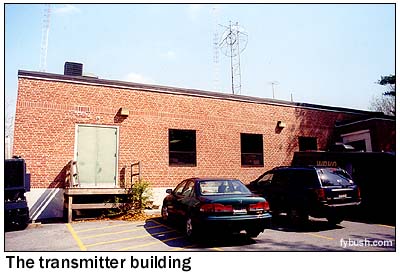 |
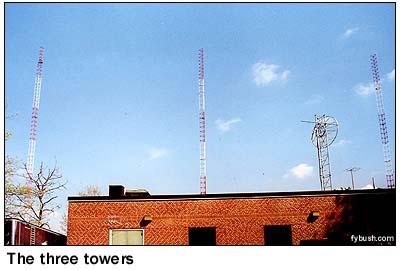 |
About a month ago, we loaded baby Ariel into the NERW-mobile and headed east to show her our old stomping grounds in and around Boston. Amazingly, during our seven-year run in the Hub we never made it inside some of the most interesting broadcast facilities in town - and it was well past time to rectify some of those gaps in the collection.
So with trusty tower-hunting companion Garrett Wollman at the wheel, we set off to see some of what we'd missed (or seen only from a distance) back in the early nineties, beginning with two of the bigger AM signals in town.
The station now known as WEEI 850 is a product of the legacies of two heritage Boston stations. The calls and programming came over from WEEI 590 a decade ago, replacing the station that had been known as WHDH since way back in 1930. WHDH actually began in Gloucester, the successor to an early station there called WEPS (a distant ancestor of today's WORC in Worcester), but soon moved to Boston, with a transmitter site in Saugus, close to the present-day WROL 950 tower.
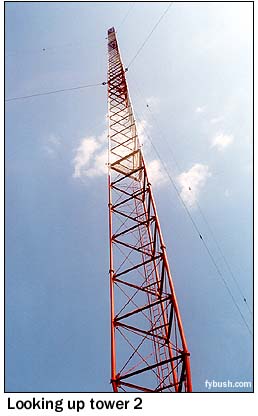 After
World War II, WHDH upgraded from a kilowatt daytimer to 5000
and then to 50,000 watts, building this site way out on Central
Avenue in Needham, in what were then the distant western fringes
of Boston's suburbia. As you head out Central Avenue from Needham
Center, the road twists and turns past the town dump before you
arrive at a barely-marked driveway to a rod and gun club - and
at the back of the gun club's parking lot is the gate that leads
back to the building and towers.
After
World War II, WHDH upgraded from a kilowatt daytimer to 5000
and then to 50,000 watts, building this site way out on Central
Avenue in Needham, in what were then the distant western fringes
of Boston's suburbia. As you head out Central Avenue from Needham
Center, the road twists and turns past the town dump before you
arrive at a barely-marked driveway to a rod and gun club - and
at the back of the gun club's parking lot is the gate that leads
back to the building and towers.
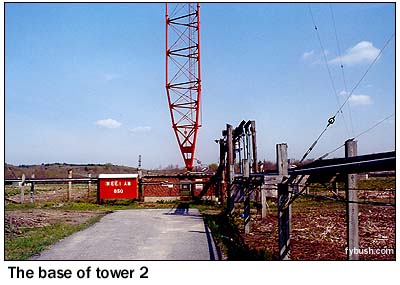
Distance and foliage - not to mention the proximity to the really tall TV/FM towers over by Route 128 and the wide profiles of these old Truscon towers - are deceptive here. Would you believe these towers are 608, 650 and 568 feet tall? They're also still fed by above-ground transmission line, though the old open-wire stuff has long since given way to coax.
(I'd long wondered why the top of tower 1 is narrower than the rest of the towers: apparently WHDH once intended to try to put TV on the air from here. By the time WHDH finally got its license for channel 5 in 1957, it instead built a much taller tower over by Route 128, and no TV or FM ever operated here.)
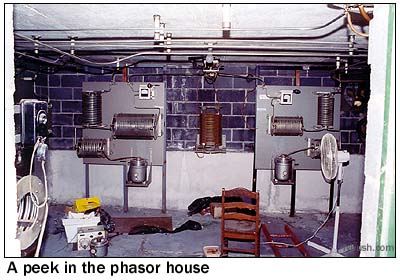 It's
an unusual configuration here - instead of having a phasor cabinet
in the transmitter building, the phasor is built into that squat
brick building at the base of tower 2. WEEI chief engineer John
Kennedy, our tour guide this beautiful April morning, opened
the door for us to stick the camera lens in, but that's clearly
not someplace you want to go inside when the station's on the
air, and so we didn't.
It's
an unusual configuration here - instead of having a phasor cabinet
in the transmitter building, the phasor is built into that squat
brick building at the base of tower 2. WEEI chief engineer John
Kennedy, our tour guide this beautiful April morning, opened
the door for us to stick the camera lens in, but that's clearly
not someplace you want to go inside when the station's on the
air, and so we didn't.
A few more notes outside, before we go in: when this three-tower array was designed in the forties, the signal it generated covered most of Boston's population beautifully. Both day and night, the bulk of the signal is aimed east-northeast at downtown Boston, some 12 miles away. It goes north and south quite well, but it doesn't go west, which was much less of a liability in 1947 than it is 55 years later, when so much of Boston's suburban growth extends out that way. (That western null is understandable when you remember that 850 is a I-A clear channel in Denver at KOA; the holes between WHDH and KOA were filled later on by sizable night signals in places like Cleveland and Johnstown, Pennsylvania, not to mention a 50 kW signal up in Montreal at the old CKVL, now dark. It makes for a noisy channel in places like Rochester!)
As a result, Entercom (which acquired WEEI when it bought most of American Radio Systems' Boston stations from Infinity in 1998) has turned to some unusual strategies to extend the reach of the sports programming, adding simulcasts to the west in Worcester (WVEI 1440) and, just this past spring, in Rhode Island (WEEI-FM 103.7 Westerly-Providence). Still, for the suffering Red Sox fans far to the west of Boston, this flagship signal isn't where we get our Crimson Hose fix on summer evenings; that honor goes to Hartford's WTIC 1080. (Which is itself long overdue for a Site of the Week visit, but that'll be another trip eventually.)
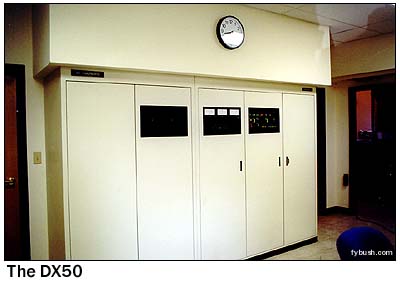 |
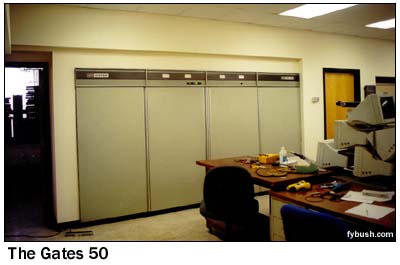 |
Let's head inside the building now, where the old transmitter room is now a combination of transmitters and storage of office furniture and equipment. 850 went through four studios in just the last decade and a half (441 Stuart Street in the Back Bay; 7 Bulfinch Place at Government Center during a brief interlude of co-ownership with channel 7, which took the WHDH-TV calls and kept them after selling off the radio station; 116 Huntington Avenue at the old ARS headquarters and now 20 Guest Street in Brighton), and so there are lots of desks, computers and even an entire telephone system in storage out here.
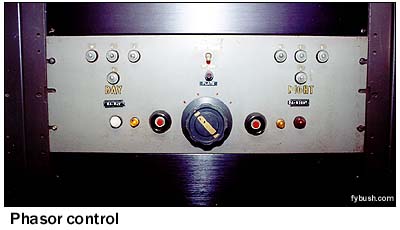 |
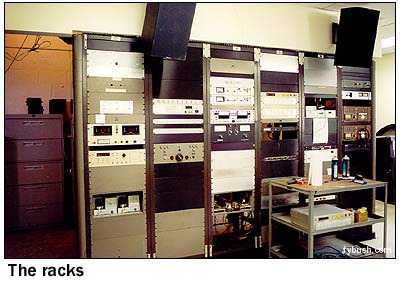 |
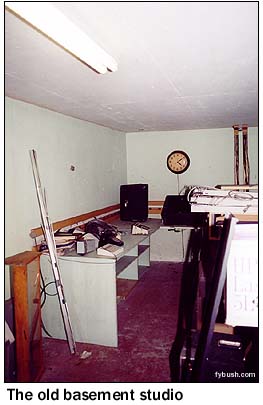 The
main transmitter is a Harris DX50, with an older Gates MW50 as
backup. Among the newer gear in the racks at one end of the room
sits what's believed to be the oldest piece of equipment out
here, the 1947-vintage control panel for the phasor.
The
main transmitter is a Harris DX50, with an older Gates MW50 as
backup. Among the newer gear in the racks at one end of the room
sits what's believed to be the oldest piece of equipment out
here, the 1947-vintage control panel for the phasor.
And, this being an older transmitter site, there's a basement full of goodies, too. The fallout shelter in the basement is no longer operative as a studio, alas, but you can see what once was down here.
In the next room over are piles of unloved, unwanted cart machines, soon to be hauled out to the trash unless someone wants them (John would be more than happy to part with them!), and a big safe that holds what's left of the corporate records of the old Herald Traveler Corporation, which once owned the Boston Herald-Traveler newspaper, WHDH-TV (Channel 5) and WHDH radio and TV. After the WHDH-TV license was pulled by the FCC in 1972 (a very long story that involved concerns over market share and cross-ownership and very possibly some back-office maneuvering by the Kennedy family, too), the company quickly ceased to be, with the radio stations as its last asset, so it's really no surprise that the old stock certificates and accounting books ended up out here.
Once we'd seen 850, it was off to their sister station, WRKO 680 - but we'll show you that next week!
Still haven't ordered? It's not too late - Tower Site Calendar 2004 is STILL AVAILABLE! If you haven't yet ordered, what are you waiting for? Click here for ordering information!
- Previous Site of the Week: New York's North Country
- Next Week: WRKO, Boston
- Site of the Week INDEX!
- How can you help support Site of the Week? Click here!
- Submit your suggestions for a future Site of the Week!
